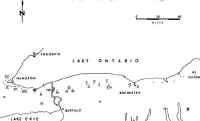|
1966. Ph.D., 420 pp. McMaster University, Hamilton,
ON.
THE SEDIMENTOLOGY OF THE MEDINA FORMATION OUTCROPPING ALONG
THE NIAGARA ESCARPMENT (ONTARIO AND NEW YORK STATE
Martini, I. P.
 Detailed
studies of sedimentological sequences, primary sedimentary structure, and
textural relationship have provided new information concerning the
paleoenvironmental setting of the Lower Silurian Medina Formation outcropping
along the Niagara Escarpment in Ontario and New York State. Detailed
studies of sedimentological sequences, primary sedimentary structure, and
textural relationship have provided new information concerning the
paleoenvironmental setting of the Lower Silurian Medina Formation outcropping
along the Niagara Escarpment in Ontario and New York State.
The analysis of cross bedding and other primary directional
sedimentary structures, the determination of quartz grain orientation on
more than 150 samples of the Thorold and Grimsby Sandstones yielded a general
paleocurrent trend to the North and North-West. The source area of the Medina
sand is believed to be the Bald-Eagle, Juniata formations of the Appalachians.
A second line of movement of the paleoflow, in direction
South-West and North-East has been detected in part of the New York outcrops,
and in the Ontario region. This paleocurrent trend seems to have been related to
marine agents reworking a hypothesized submerged deltaic complex. The regional
variation of several sedimentological parameters, such as grain size, packing,
boron concentrations, faunal assemblages and so on, confirm a mixed environment
with a deltaic complex model of sedimentation for the Medina Formation.
Accordingl1y, the primary constructive phase of the Medina delta
is believed to be limited to the Lockport-Rochester region and only partially
reflected in the sections to the west and east. A shift of the deltaic channel
complex resulted in a second area of clastic input in the Niagara- De Cew Falls
region where the marine agents were competent enough to redistribute the
delta-born sediments to a minor or major degree.
A shallow Silurian sea and a very slow basinal subsidence
yielded a complex interfingering of top-set environments varying from a
submerged channel sedimentation to tidal flat, as demonstrated by the presence
of Lingula shells to high tidal-flat flood-plain settings characterized
by a well developed "Burrow zone". The foreset part of the delta may
be represented by the sublittoral Cabot Head and Lower Grimsby in the Hamilton
area.
The model herein presented does not significantly differ from
the one constructed by Fisher (1954) except in stressing a more detaile4
analysis and the introduction of a submerged delta concept.
A detailed study of quartz grain orientation confirms the
validity of the appositional fabric as a paleocurrent indicator. The study has
also revealed, however, that potential errors (e.g. misinterpretation of the
primary surface of deposition) or a generalized analysis
(i.e. assumption of homogeneous population) could lead to
geological1y erroneous or irrelevant inferences.
|